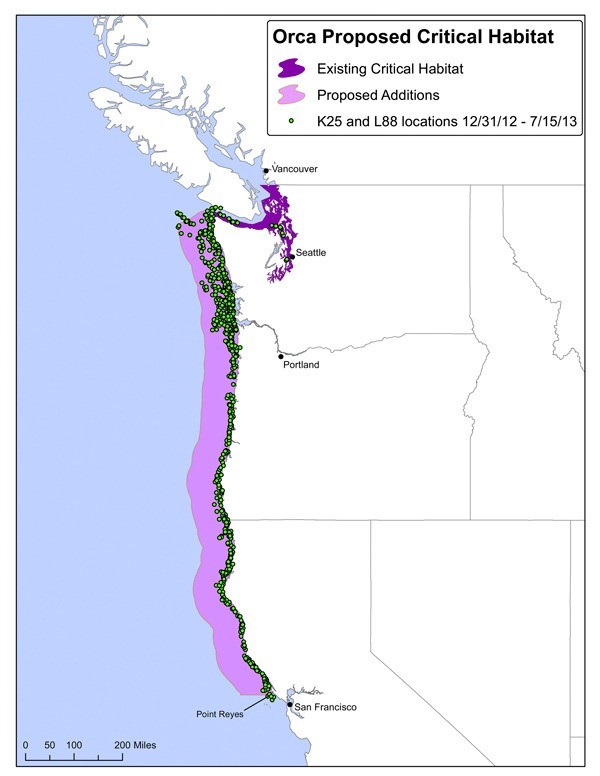The critical habitat afforded to the endangered Southern Resident killer whales could expand to include 700 miles of coastline, but it won’t happen anytime soon.
National Marine Fisheries Service, the agency that will oversee the decision, says it will need until 2017 to gather scientific evidence and make an informed ruling. Local orca advocates say the expansion is long overdue and the delay effectively allows military to obtain permits for continued testing and training off the Washington coast.
A petition for revision of the Southern Resident’s critical habitat was filed nearly a year ago by the Center for Biological Diversity, a San Francisco-based environmental organization that focuses on protecting endangered animals and their habitats. That petition was accepted by NMFS Feb. 23.
“It’s a bittersweet response,” said Center Oceans Director Miyoko Sakashita. “On one hand they [NMFS] have taken steps to protect and expand the critical habitat, but it’s quite disappointing that there won’t be a proposed rule until 2017.”
If successful, the proposal would extend Endangered Species Act protection to the whales’ winter foraging range off the coastline of Washington, Oregon and California.
The critical habitat, as it stands today, consists of roughly 2,500 square miles within Puget Sound—the core of the orca’s summer range.
With the recent addition of two newborn calves, the Southern Resident population totals 79 animals, still a 30-year-low.
Endangered animals with critical habitat protection are twice as likely to be in recovery, Sakashita said.
So, why the wait to expand critical habitat?
The agency doesn’t have a good understanding of what specific areas are used by the orcas along the coast and two years will allow enough time for proper research and analysis, NMFS spokesman Michael Milstein said.
“The petition did provide significant information indicating that revising critical habitat is warranted,” Milstein said. “Based on research that’s under way we think this is a reasonable amount of time.”
That research includes mapping salmon distribution, tagging and tracking whales, and acoustic recorders that pick up the whale calls to indicate where they spend time.
But Ken Balcomb, founder of the Center for Whale Research isn’t convinced that more research is needed.
“We can account for where the whales spend all of their time, year-round.” Balcomb said. “There’s no data deficiency. This is a strategy and an excuse to buy time.”
Buy time for what, exactly? For the Navy to obtain permits for continued testing and training in the Olympic National Marine Sanctuary, according to Balcomb.
The Marine Sanctuary is an area of ocean the size of Puerto Rico that begins at the mouth of the Strait of Juan De Fuca (the end point of the Southern Resident’s critical habitat) and points south.
“They [NMFS] couldn’t allow the permit if it were critical habitat,” Balcomb said.
The Navy’s Pacific Fleet is compiling an environment impact study of the Northwest training and testing. It is being conducted, in part, for a reauthorization of permits for continued training and testing in compliance with the Marine Mammal Protection and Endangered Species acts. Current authorizations expire in November of this year.
Training activities in the sanctuary include use of various sonar systems, a practice that Balcomb said is detrimental to the health of whales.
Still, critical habitat as a determining factor for the military’s use of the area could prove inconsequential. Areas within the boundaries of the critical habitat as it exists today are already used for military testing and training.
What the Navy needs from NMFS to continue its testing and training is an “authorization of incidental take,” according to Milstein.
This authorization, which expires in November, allows for “unintentional harm or harassment of an endangered species as long as it affects a small portion, has no more than a negligible effect, and does not have an unmitigable effect,” he said.



